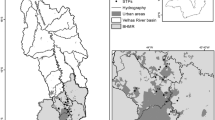Abstract
Centralized sewage treatment plants may not be a sustainable solution for a developing country such as India. Therefore, we conducted for the first time an integrated assessment of the different technologies currently used for sewage treatment in the state of West Bengal, India. Five decentralized sewage treatment plants and one centralized sewage treatment plant located in different parts of Kolkata were evaluated. We compared influent and effluent water quality, energy consumed, capital and operating costs, and treated wastewater reuse potential. F test was used to validate results on the effect of working days and holidays and seasons on treated water quality. Wastewater management strategy was assessed by performance indicators. Our results show that treatment efficiency was lowest in anaerobic plants not because of faulty technology but due to unskilled operation. Therefore, performance improvement of plants is expected if factors such as monitoring, training of staff, regular and scrupulous desludging, reuse aspects, and rational water tariff are implemented earnestly.

Similar content being viewed by others
References
APHA (1998) WEF, standard methods for the examination of water and wastewater 20th edition-4500-NO3-D nitrate electrode method. American Public Health Association, Washington, DC
Barber WP, Stuckey DC (1999) The use of the anaerobic baffled reactor (ABR) for wastewater treatment: a review. Water Res 33(7):1559–1578
Birol E, Das S (2010) Estimating the value of improved wastewater treatment: the case of River Ganga, India. J Environ Manag 91(11):2163–2171
Buntner D, Sánchez A, Garrido JM (2013) Feasibility of combined UASB and MBR system in dairy wastewater treatment at ambient temperatures. Chem Eng J 230:475–481
Calheiros CSC, Bessa VS, Mesquita RBR, Brix H, Rangel AOSS, Castro PML (2015) Constructed wetland with a polyculture of ornamental plants for wastewater treatment at a rural tourism facility. Ecol Eng 79:1–7
Chen S, Chen B (2013) Net energy production and emissions mitigation of domestic wastewater treatment system: a comparison of different biogas-sludge use alternatives. Bioresour Technol 144:296–303
CPCB (2005) Status of Sewage Treatment in India, Central Pollution Control Board, India. http://www.cpcb.nic.in/newitems/12.pdf. 3 Sept 2014
CPCB (2013) Performance evaluation of sewage treatment plants under NRCD, Central Pollution Control Board, India. http://cpcb.nic.in/upload/NewItems/NewItem_195_STP_REPORT.pdf. 3 Sept 2014
Daghrir R, Drogui P (2013) Coupled electrocoagulation-electro-Fenton for efficient domestic wastewater treatment. Environ Chem Lett 11(2):151–156
Garcia SN, Clubbs RL, Stanley JK, Scheffe B, Yelderman JC Jr, Brooks BW (2013) Comparative analysis of effluent water quality from a municipal treatment plant and two on-site wastewater treatment systems. Chemosphere 92(1):38–44
Libralato G, Volpi Ghirardini A, Avezzù F (2012) To centralise or to decentralise: an overview of the most recent trends in wastewater treatment management. J Environ Manage 94(1):61–68
Lim SJ, Kim TH (2014) Applicability and trends of anaerobic granular sludge treatment processes. Biomass Bioenergy 60:189–202
Mankad A, Tapsuwan S (2011) Review of socio-economic drivers of community acceptance and adoption of decentralised water systems. J Environ Manag 92(3):380–391
Massoud MA, Tarhini A, Nasr JA (2009) Decentralized approaches to wastewater treatment and management: applicability in developing countries. J Environ Manag 90(1):652–659
Rodriguez-Garcia G, Molinos-Senante M, Hospido A, Hernández-Sancho F, Moreira MT, Feijoo G (2011) Environmental and economic profile of six typologies of wastewater treatment plants. Water Res 45(18):5997–6010
Sujaritpong S, Nitivattananon V (2009) Factors influencing wastewater management performance: case study of housing estates in suburban Bangkok, Thailand. J Environ Manag 90(1):455–465
Suriyachan C, Nitivattananon V, Amin ATMN (2012) Potential of decentralized wastewater management for urban development: case of Bangkok. Habitat Int 36(1):85–92
Van Haandel AC, Lettinga G (1994) Anaerobic sewage treatment: a practical guide for regions with a hot climate. Wiley, New York
Acknowledgments
Grant received from Department of Science and Technology, Government of India (File No. DST/IMRCD/SARASWATI/2012/(CP)(ii)), to undertake this work is duly acknowledged.
Author information
Authors and Affiliations
Corresponding author
Rights and permissions
About this article
Cite this article
Chatterjee, P., Ghangrekar, M.M. & Rao, S. Low efficiency of sewage treatment plants due to unskilled operations in India. Environ Chem Lett 14, 407–416 (2016). https://doi.org/10.1007/s10311-016-0551-9
Received:
Accepted:
Published:
Issue Date:
DOI: https://doi.org/10.1007/s10311-016-0551-9




